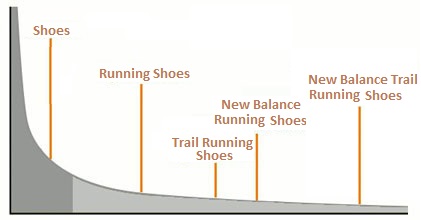Beginners Guide: Advantages Of Targeting Long‑Tail Keywords

When starting your first search marketing campaign, many beginners do exactly what I did: focus on popular, high-volume keywords versus relevant, rank-able phrases. Typically, it doesn’t take very long to determine that those high volume keywords usually don’t convert, or they have so much competition that it’s extremely difficult to garner any traffic at all.
Understanding the power of long-tail keywords can help identify less competitive markets allowing content to rank higher, earlier, and convert more. Below is a beginners summary outlining the advantages of choosing the correct long-tail phrases, and a few resources to help you get started with long-tail keyword selection and marketing efforts.
First, Let’s Define Long-Tail Keywords
Long-tail keywords are longer, more specific keywords that are less common, individually, but add up to account for the majority of search-driven traffic. Long tail keywords are the opposite of “head” terms, which are more popular and more frequently searched.
Advantages of Targeting Long-Tail Keywords
Lower Competition: Again, a mistake that many people make when diving in to search marketing: overemphasizing keyword volume and underestimating keyword competition.
Let’s say for a moment, you decided to start jogging and your goal was to win a race. Would you choose your first race as the Boston Marathon?

No, because far too many people compete to win that same race. Many of those people are much more prepared and experienced.
If your goal is to compete and win, it would be smarter to focus your effort in a lower competition race, Right?
The same concept applies to finding long-tail phrase with high potential to win. It’s finding focused keyword phrases with less competition and greater opportunity to rank and gain traffic. As you continue to grow as a search marketer, you will quickly understand the value of selecting a low volume phrase that bring people from the SERP to your site.
Relevant Long-Tail Phrases
Understanding the importance of selecting relevant long-tail phrases, is just as important as understanding the value of low competition. Just because you’ve found a long tail keyword that is rank-able, it doesn’t mean it will drive conversions on your website. Make sure that you can create content surrounding the long tail phrase that matches the intent of the keyword phrase and aligns with your site. To the same point described above, low volume, converting traffic is much more effective than high volume, non-converting traffic.

A Few Tips and Resources to Get Started…
1. Research
Determine an initial set of keywords that match the purpose of your website. For the example above, these keywords might be shoes, running shoes or men’s running shoes. Then, use those as a starting point to find relevant long-tail keywords that have lower competition. You can enter these keywords into any of the following tools to get long tail ideas:
- Google Keyword Planner
- Long-Tail Pro
- Market Samari
Note that in order to use Google’s Keyword Planner, you must log in via an AdWords account. Do you know of other helpful tools? Feel free to comment below so that we can share different resources. Also check out this Luna post for other helpful free resources.
2. Competitive Analysis

Once you’ve compiled a list of potential long-tail phrases, it’s time to analyze. In my mind, this is 99% of the battle. Taking extra time and effort to identify least competitive, relevant keywords will save you time and give you the opportunity to rank well. Long-Tail Pro an excellent tool to gauge that competitive insight. Additionally, their website has a bunch of free resources to teach competitive analysis. This post contains some fantastic resources that you can use to evaluate competition.
3. Create Awesome, Relevant Content Around the Long-Tail Topic
It is more important than ever to create awesome, engaging content around your key terms. Internet content expands and grows everyday. More content = pickier readers, so don’t disappoint your audience. Michael Bartholow wrote a great article that touches on context relevance and its importance to readers.
4. Optimize Your Page for that Term
Many people stop here. But if you’re new to SEO, see Chris Vella’s Easy Guide to SEO Basics for helpful content optimization tips. For example, properly tagging your headers, pictures and the rest of your content can go a long way in helping search engines identify your content as relevant.
Summary
Hope this helps with your general understanding of long-tail phrases and why they can be advantageous! What tools do you use to help you with long-tail keyword selection? Let me know in the comments below!